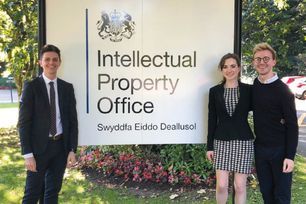Who owns what?
Kate Swaine defines the scope of employee ownership when it comes to IP.

All businesses own and use intellectual property, whether they are an innovative patent- or design-led business or simply applying a name to their goods.
These rights come into being in a number of ways, and understanding what IP rights exist and where they vest is crucial to maximising a company’s ability to protect and use its IP and strengthen its business.
In particular, it is vital that any business understands its IP rights in the context of arrangements with employees and third-party contractors, and this article aims to explain who owns what, across a range of relevant rights.
Registered rights
Of course, the prima facie owner of a registered IP right is the individual or entity identified as the applicant and owner of it. This is the case, for example, for registered trade marks, registered designs, domain names and patents of all types. Therefore, all applications for such rights should be made in the name of the business or individual intended to own the right. If the registration is made in the wrong name or needs to be changed at a later date, it can be transferred to the correct entity by way of assignment, assuming the relevant parties agree.
However, if the relevant parties are not in agreement, resolving the issue may not be straightforward. For example, consider the position between a company and a former contractor who decides to seek trade mark rights in the name of a product they created, or to seek a declaration of invalidity in relation to a trade mark registration on the basis that the application was made in breach of s3 or s5 of the Trade Marks Act 1994. If successful, the registration would be declared invalid as opposed to being transferred to the company. The company could then file a fresh application in its own name, but it would not have the benefit of the filing date of the original application. To avoid this, it is vital that there is clarity from the start as to ownership of the rights created.
Unregistered rights
For unregistered rights, the general rule is that works created by an employee will be owned by the employer, provided that the works were created during the course of their employment. This is the case, for example, with copyright, unregistered design rights and rights in databases. It is possible to contract away from the statutory position in the employee’s favour, but doing so will not usually be in the interests of the employer.
Ownership of unregistered rights, as between an individual and the business for which they are working, depends on a combination of factors, including the individual’s employment status, the terms of that agreement, the context in which the relevant work is undertaken and the statutory position in respect of the relevant type(s) of IP right. This is the case for copyright, unregistered design rights, rights in inventions, rights in confidential information and trade secrets more generally.
Although the general rule is that works created by an employee will be owned by the employer, provided that the works were created “in the course of employment” (the legislation is worded slightly differently for inventions, as noted below), the case law indicates that disputes sometimes arise as to whether an individual counts as an “employee” and whether the relevant work was indeed done “in the course of employment”.
Commentators have noted that, when addressed in IP contexts, there is often a desire to show that the individual was an employee and hence the company owns the IP in question. In this respect, contrasting approaches can be seen in A Fulton Co. v Grant Barnett & Co.1, where the individual designer was chairman, chief executive and director with no service contract, but was held to be an employee. On the other hand, in Ultraframe v Fielding2, the director (and sole shareholder) was held not to be an employee.
Whether the relevant work was done “in the course of employment” will also be a question of fact. Factors to be taken into account include whether the work falls within the employee’s normal duties or as an additional duty specifically assigned to the employee. For example, just because work is done during working hours does not necessarily mean that the criteria is met and that the IP arising from the work is owned by the employer. Conversely, work done outside working hours but within the job description of the employee may fall within the course of employment.
For workers who are not employees, such as consultants, the individual will usually be the first owner of any IP arising in works created in the course of their services. In order to ensure that such IP becomes owned by the “employer”, provisions expressly stating that to be the case should be included in the contract governing the relationship between the parties.
Similarly, if a company commissions another party to create a work, such as a logo, the first owner of rights arising in the logo (for example, copyright and an unregistered design right) will be the individual who created it or that individual’s employer. Again, in order for the commissioning company to own the IP in the logo and to be able to fully enforce it against an infringer, the contract governing the commissioned work needs to make provision for the assignment of all IP arising in the logo to the commissioning company. It is usually easier to agree this before any work is undertaken or an agreement signed. Retrospectively trying to secure an assignment can prove expensive for the commissioning party and result in a request for additional payments.
Other rights
A few other particular rights are worth considering. Let’s begin with moral rights. These arise in favour of the creators of copyright-protected works. Moral rights are owned by the creator of the work (even if they are an employee) and cannot be assigned away. Instead, if the employer would prefer not to recognise the creator of the relevant work(s) on all subsequent copies and wants to avoid difficulties with subsequent editing or adaption, they should seek an express waiver of moral rights from the employee.
Other considerations govern confidential information and trade secrets. Between a company, its employees and other workers, obligations of confidentiality will be determined by both contractual terms (express and implied) and the equitable obligation of confidence. This is an area of common law, the leading cases being (the wonderfully named) Faccenda Chicken v Fowler3 and Vestergaard v Bestnet4, as recently confirmed and applied in the context of the 2016 EU Trade Secrets Directive in Trailfinders v Travel Counsellors.5
Common law distinguishes between various types of information that become known by an employee, each affording different levels of protection. The most secret information will continue to remain protected after an employee’s employment has ended. A lesser category of information must be treated as confidential during the term of employment but, once learned, becomes a part of the employee’s skill and knowledge. This information may be used by them after the termination of their employment. Information that is trivial or in the public domain cannot be treated as confidential.
Where there is a dispute, the terms of the relationship between the parties, the relevant facts and the context of those facts will be relevant to determining the outcome. A company’s contractual arrangements with employees and other workers should therefore be prepared with sensitivity to the individual’s role and the level of confidential information that is likely to come into their knowledge.
As regards inventions and patents, the broad position is that the employer will own rights arising in inventions made by an employee in the course of carrying out their normal duties, or duties that were specifically assigned to them in circumstances such that an invention was reasonably expected to result. For employees with a special obligation towards the employer (eg, directors), the employer will own inventions created while carrying out their duties. Further, the Patents Act 1977 provides for compensation to employee inventors for inventions (and patents) that prove to be of outstanding benefit. A recent example of a dispute in this area is the case of Shanks v Unilever6, in which an employee was awarded compensation of £2m in respect of patents obtained on inventions by Shanks both within and outside his usual working hours.
Freedom of contract
The importance of ensuring that contractual arrangements reflect agreed expectations on the ownership and management of IP is clear. Although UK law provides employers with a reasonable default position with respect to employees, there is little backup for employers where contractual arrangements with other types of workers are deficient. For non-employees, the default is that unregistered IP vests with the individual.
It is possible for IP provisions in contractual arrangements to differ from the default positions provided by statute, with some exceptions. Most notably, it is not possible to vary by contract, to the detriment of the employee, the statutory default provided in respect of inventions and patents. Any contract purporting to do so will be unenforceable to that extent.
Recently, the Court of Appeal’s judgment in Gray v Mulberry7 strengthened the position of employers seeking deep and comprehensive IP provisions in a contract of employment. Gray had taken a job with Mulberry as a Market Support Assistant. Mulberry required its employees to sign both an employment contract containing a confidentiality clause and a copyright agreement, both of which contained employer-favoured clauses. The copyright agreement featured a clause assigning to Mulberry “all copyright works and designs originated, conceived, written or made by you during the period of your service”.
Gray had signed the employment contract but refused to sign the copyright agreement on the basis that she believed it could capture her artistic activities away from work (as a writer and filmmaker). She was eventually dismissed for her failure to sign.
Gray ultimately bought a claim for discrimination on the grounds of belief, defined as “the statutory human or moral right to own the copyright and moral rights of her own creative works and output, except when that creative work or output is produced on behalf of her employer”. She was unsuccessful at each instance. The Court of Appeal’s view was that Gray’s “crisis of conscience” about signing the copyright agreement could be described as purely commercial and designed to protect her own private interests. As such, the alleged belief lacked sufficient cogency to qualify as a philosophical belief protected under the Equality Act 2010.
Recommendations
Ultimately, all working relationships between businesses and individuals should be governed by contract. The parties should be clear about the nature of the relationship sought and satisfy themselves that it is appropriate to the real-world operation of their relationship. The employment agreement or other contract should be clearly drafted and make arrangements for IP appropriate to the type of agreement, the role of the individual and the context of their work.
Best practice, with a view to avoiding dispute as to the meaning of “in the course of employment”, is to clearly define the scope of the employee’s role. If the role is likely to include inventing and/or designing something, making improvements, or generating or coming into contact with confidential information, it should include a requirement for notification of new designs, inventions and so on. Proactive employer engagement with key inventors and designers – for example, appropriate recognition and sensitive rewards for any advancements made – may assist in maintaining positive relationships and avoiding the statutory regime for inventor compensation being called upon. Remember also that contracts and descriptions should be updated when duties change.
For some roles, a periodic review and capture of any IP rights (including confidential information) that are likely to have arisen or come within the individual’s knowledge may be appropriate. As well as keeping the relationship between, and the positions of, the parties clear, this review process may also support best practice in IP management by the business itself. Capturing what was created, when and by whom underpins effective IP use for commercial success.
IP in employment: Get it right
- It is vital that there is clarity from the start as to ownership of the rights created.
- Applications for registered rights should be made in the name of the business or individual intended to own the right.
- A contract governing commissioned work must make provision for the assignment of all IP arising in the work.
- An employer that wishes not to recognise the author of the relevant work(s) on all subsequent copies should seek an express waiver of moral rights from the employee at the outset.
- A company’s contractual arrangements with employees and other workers should be prepared with sensitivity to the individual’s role and the level of confidential information that is likely to come into their knowledge.
- Contractual arrangements must clearly reflect agreed expectations about the ownership and management of IP. There is little legal recourse for employers where contractual arrangements are deficient.
1 [2000] EWCA Civ 513
2 [2003] EWCA Civ 1805
3 [1987] Ch 117
4 [2013] UKSC 31
5 [2020] EWHC 591 (IPEC)
6 [2019] UKSC 45
7 [2019] EWCA Civ 1720
More CITMA Review features:
A right royal rout
Lee Curtis reflects on the questions raised by the attempted registration of a high-born brand.
A question of Pride
Support for diversity and inclusion or simply opportunistic “rainbow-washing”? What does the adoption of the rainbow mean for the credibility of an iconic symbol?
Hello, IPO!
What did a group of newly qualified attorneys learn from going behind the scenes in Newport?
Harmonisation: New code, new options
Wondering what EU harmonisation means for Italy’s trade mark owners? Paola Gelato breaks down three important changes.





